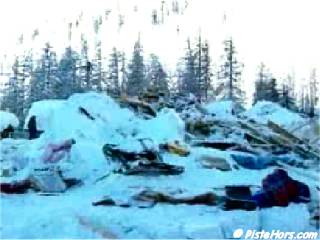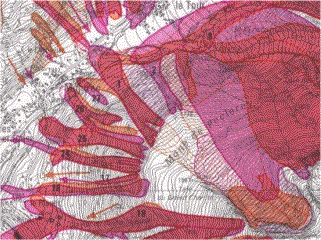
The last legal lap in the Montroc avalanche may finally have been run in Grenoble’s Administrative Court this summer, more than seven years after the events that killed 12 people in their homes in the hamlet of les Poses. Four sets of claimants, relatives of the deceased as well as the commune’s insurer AXA sought significant damages against Chamonix and the French state for their role in the tragedy.

The case effectively consisted of two separate claims. That of Axa Insurance who was seeking reimbursement from the state of compensation that was paid on behalf of the community of Chamonix and that of four sets of relatives.
With respect to Axa the judgement noted that no decision was made by the mayor to evacuate the village of Montroc but the access road to the village had been closed. The state has, as part of its police powers, the obligation to establish zones exposed to risk. This does not exclude the mayor from using his own powers to ensure safety as and when necessary and on this count Michel Charlet, the mayor of Chamonix, had already been found guilty by Bonneville criminal court.
During the severe weather conditions in February 1999 M. Charlet relied on the avalanche consultative committee which met before and during the crisis. The role of the committee is to manage evacuations and other measures during severe weather alerts. The committee used the map of likely avalanche paths (Cartes de localisation probable des Avalanches – CLPA) as an occasional support tool when making decisions. The CLPA was also used as the basis of various zoning and planning documents used by Chamonix (PZEA, PER, PUD etc.). The CLPA is an historic document of where avalanches have occurred in the past, it does not say where they will occur in the future although known avalanche paths, such as those above Montroc, tend to slide under similar snow and weather conditions.

The 1991 CLPA showing the Péclerey avalanche 1
Grenoble Administrative Court found that M. Charlet did not rely on the CLPA nor was it used on a regular basis. Instead the Mayor based his decisions on advice from senior members of the avalanche consultative committee. The fact that the avalanche paths mentioned in the CLPA were not sufficiently accounted for had no link with the Mayor’s negligence with respect of the evacuation measures for the site which subsequently turned out to be necessary
Normally safety in communities is the sole responsibility of the Mayor but a special case exists in mountain areas (zones above 600 meters altitude) where the prefet (a government appointed departmental governor) has responsibility. Presumably because of the increased danger in these areas.
The court decided that although M. Charlet took insufficient steps, no “substantial” mistake can be attributed to the prefet for failing to overrule the mayor. The word substantial is important as it requires a higher burden of evidence on behalf of plaintiffs. The action was dismissed by the court.
The court also heard pleadings from four sets of claimants, all relatives of the deceased. They sought an order that the state and the community be held jointly and severally liable to pay compensation. The claimants maintained that the commune and state were liable due to a mistake having been made or alternatively that their liability involved no mistake. That seems to cover all bases.
Taking the second point of liability without error. Article L.160-5 of the code de l’urbanisme (planning law) states “that the public authorities are not liable for any problem resulting from the use of land, the height of buildings, the prohibition to build in certain areas etc.” However there is an exception and compensation may be due “if there is a breach of existing rights or if there is a modification to the former state of the area which leads to direct material and certain loss”. For the Montroc avalanche the claimants did not establish to the satisfaction of the court that they fell within the scope of the exception to the general rule of non liability and their claim was dismissed on this basis.
Looking at the history of Montroc this part of the judgement seems perverse. Eleven of the buildings destroyed were in a white zone, classed as having no risk from avalanche. However there were oversights in the preparation of the original planning document. A revision of the CLPA in 1991 showed the historic avalanche paths as covering the white zone. This would appear to be covered by the exception mentioned by Article L.160-5. The court’s judgement does not give any reason for their decision and this will make any appeal more complicated.
Returning to the first point. One of the claims was dismissed on the basis that with planning permission having been issued in 1982 the claimant could not blame the commune or the state for the potential illegalities which might have affected the POS (Plan d’Occupation des Sols: Area development plan) and the PER (Plan Evaluation des Risks: Risk Evaluation Plan). Which were subsequently issued in 1991 and 1992. Again the judgement did not address the irregularities which led to the area being zoned for construction in 1979.
The other claims were dismissed on the basis that the state’s fault was not proved. If there was a real risk when the original 1973 CLPA was updated in 1991 the administration could not be blamed for not having taken into account an avalanche risk that had only been mentioned by a single person when the original public inquiry was held in 1973. In fact the person who claimed that the site of Montroc was at risk was none other than respected guide Armand Charlet who had lived all his live in the hamlet. Isabelle Madesclaire, a young town planner who copied the original PZEA (Plan de Zonage d’Exposition aux Avalanches: Avalanche Zoning Plan) to the POS claims that she knew that “people had doubts about the PZEA but even within the civil service there was a very strong pressure for development”. She also recalled “that she was also subjected to enormous pressure from locals who would gain financially including some very aggressive letters.” No wonder the locals didn’t make a fuss about the avalanche risk.
Further Information
http://pistehors.com/backcountry/wiki/Articles/Montroc-Avalanche
http://pistehors.com/news/ski/comments/mayor-of-chamonix-in-court/
http://pistehors.com/news/ski/comments/montroc-avalanche-suspended-sentence-for-mayor/
References
Montroc, du côté juridique, Frédéric Jarry, ANENA, Neige et Avalanches, N° 105 - mars 2004.
Les Leçons de Montroc, François Carrel, Montagnes Magazine, October 2002